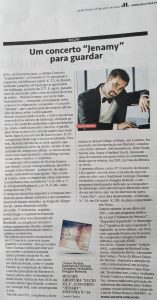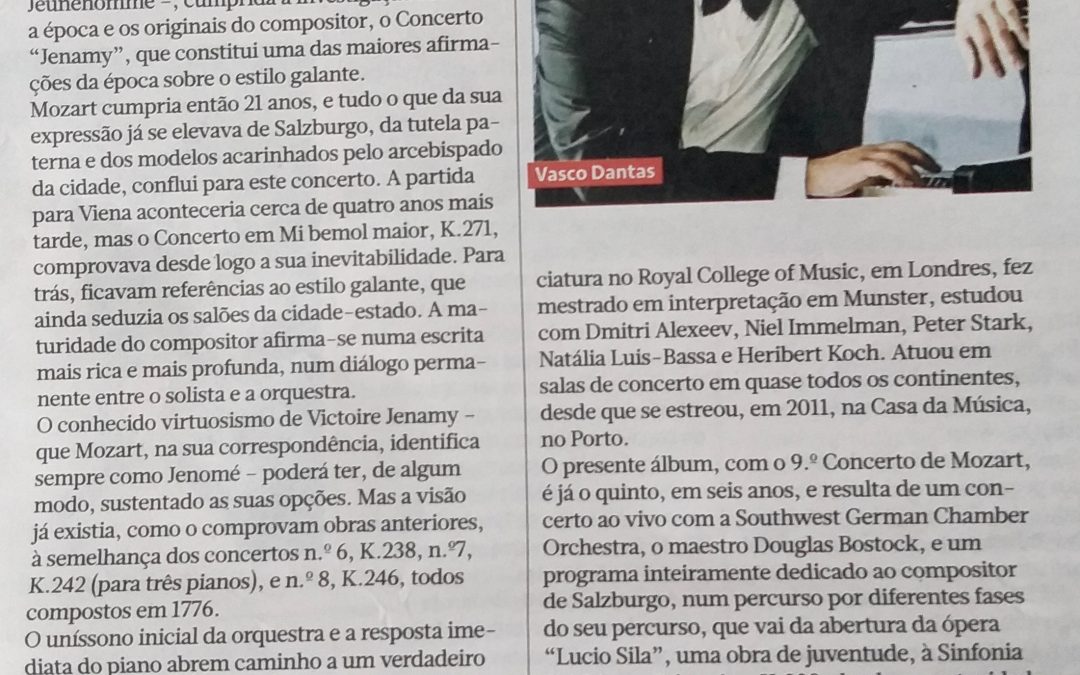(English Translation)
23rd March – 5th April 2022 – Jornal de Letras, article by Maria Augusta Gonçalves.
Until a few years ago, it was the famous Concerto “Jeunehomme”, the Concerto n.º 9, for piano and orchestra, in E flat major, K. 271, by Mozart, dedicated to the virtuoso pianist who performed in Salzburg at the beginning from 1777. It is now more than a century after the misreading of the soloist’s name – Victoire Jenamy, instead of mlle. Jeunehomme -, after completing the investigation into the time and the composer’s originals, the “Jenamy” Concerto, which constitutes one of the greatest statements of the time on the gallant style.
Mozart was then 21 years old, and everything that his expression already raised from Salzburg, from his paternal tutelage and from the models cherished by the archbishopric of the city, comes together in this concert. The departure for Vienna would take place about four years later, but the concerto in E-flat major, K. 271, immediately proved its inevitability. Behind, there were references to the Galante style, which still seduced the salons of the city-state. The composer’s maturity is confirmed in a richer and deeper writing, in a permanent dialogue between the soloist and the orchestra.
The well-known virtuosity of Victoire Jenamy — whom Mozart, in his correspondence, always identifies as Jenomé — may have, in some way, supported his options. But the vision already existed, as evidenced by previous works, similarly to concertos No. 6, K.238, No. 7, K. 242 (for three pianos), and No. 8, K.246, all composed in 1776.
The orchestra’s initial unison and the piano’s immediate response pave the way for a true thematic development, along the initial Allegro, in a dimension unprecedented until then. The Andantino, which follows, reveals long and expressive piano phrases, with a new dimension of freedom, accentuated in the third and final movement, Rondo, always in a seductive articulation between the soloist and the orchestra.
There is no shortage of memorable recordings of the 9th Concerto, but this one is one to wait and cherish. I have Vasco Dantas as a soloist and he shows why the pianist accumulates so many awards (more than 50, in about a decade, in international competitions, such as the Grand Prix in the Valletta competition and one of the main ones of Steinway & Sons), he was among the finalists for the Young Artist of the Year 2020 title, by the German magazine Opus Klassik, and entered Carnegie Hall, with a solo program.
Born in 1992, he completed a degree at the Royal College of Music, in London, took a master’s degree in Münster interpretation, studied with Dimitri Alexeev, Niel Immelman, Peter Stark, Natália Luís-Bassa and Heribert Koch. He has performed in concert halls on almost every continent since his debut in 2011 at Casa da Música in Porto.
The present no, with the 9th Mozart Concerto, is already the fifth, in six years, and results from a live concert with the Southwest German Chamber Orchestra (Südwestdeutsches Kammerorchester Pforzheim), the conductor Douglas Bostock, and a program entirely dedicated to the Salzburg composer, on a journey through different stages of his career, which includes the opening of the opera “Lucio Sila”, a youth work, to Symphony no. Vienna.
Dantas debuted on record in 2015, with a program dedicated to Liszt (“Sonetos de Petrarca”, “Spanish Rapaódia”) and Mussorgsky (“Pictures from an Exhibition”), followed by a new album, in 2016, with the great Sonata in B minor, by the Hungarian composer (both published under the KNS label).
In 2020, “Poetic Scenes” (ARS Produktion edition), with works by Robert Schumann, Vianna da Motta, Alexandre Rey Colaço, Óscar da Silva and Eduardo Burnay, would draw the attention of international critics, in magazines such as Gramophone and Opus Klassik. In the same year, with violinist Tomás Costa and cellist Isabel Vaz, he offers another reference recording of the Sonatas for violin and piano, and for cello and piano by Luís de Freitas Branco (MPMP).
JL Maria Augusta Goncalves
– –
(Original text, portuguese)
23 de Março – 5 de Abril 2022 – Jornal de Letras, escrito por Maria Augusta Gonçalves.
Foi, até há poucos anos, o célebre Concerto “Jeunehomme”, o Concerto n.º 9, para piano e orquestra, em Mi bemol maior, K. 271, de Mozart, dedicado à pianista virtuosa que se apresentou em Salzburgo, no início de 1777. É, agora, passado mais de um século sobre o erro de leitura do nome da solista – Victoire Jenamy, em vez de mlle. Jeunehomme -, cumprida a investigação sobre a época e os originais do compositor, o Concerto “Jenamy”, que constitui uma das maiores afirmações da época sobre o estilo galante.
Mozart cumpria então 21 anos, e tudo o que da sua expressão já se elevava de Salzburgo, da tutela paterna e dos modelos acarinhados pelo arcebispado da cidade, conflui para este concerto. A partida para Viena aconteceria cerca de quatro anos mais tarde, mas o concerto em mi bemol maior, K. 271, comprovava desde logo a sua inevitabilidade. Para trás, ficavam referências ao estilo Galante, que ainda seduzia os salões da cidade-estado. A maturidade do compositor afirma-se numa escrita mais rica e mais profunda, num diálogo permanente entre o solista e a orquestra.
O conhecido virtuosismo de Victoire Jenamy — que Mozart, na sua correspondência, identifica-se sempre como Jenomé — poderá ter, de algum modo, sustentados suas opções. Mas a visão já existia, como o comprovam as obras anteriores, à semelhança dos concertos n.° 6, K.238, n.° 7, K. 242 (para três pianos), e n.° 8, K.246, todos compostos em 1776.
O uníssono inicial da orquestra e a resposta imediata do piano abrem caminho a um verdadeiro desenvolvimento temático, ao longo do Allegro inicial, numa dimensão inédita até então. O Andantino, seguinte, revela longas e expressivas frases do piano, com uma nova dimensão de liberdade, acentuada no terceiro e último andamento, Rondo, sempre numa sedutora articulação entre o solista e a orquestra.
Não faltam gravações memoráveis do 9.° Concerto, mas esta é para aguardar e acarinhar. Tenho por solista Vasco Dantas e deixa perceber por que motivo o pianista acumula tantos prémios (mais de 50, em cerca de uma década, em concursos internacionais, como o Grande Prémio na competição de Valletta e um dos principais da Steinway & Sons), esteve entre os finalistas do título Jovem Artista do Ano 2020, da revista alemã Opus Klassik, e entrou no Carnegie Hall, com um programa a solo.
Nascido em 1992, completou a licenciatura no Royal College of Music, em Londres, fez mestrado em interpretação Münster, estudou com o Dimitri Alexeev, Niel Immelman, Peter Stark, Natália Luís-Bassa e Heribert Koch. Actuou em salas de concerto em quase todos os continentes, desde que se estreou, em 2011, na Casa da Música, no Porto.
O presente algum, com o 9.º Concerto de Mozart, é já o quinto, em seis anos, e resulta de um concerto ao vivo com a Southwest German Chamber Orchestra (Südwestdeutsches Kammerorchester Pforzheim), o maestro Douglas Bostock, e um programa inteiramente dedicado ao compositor de Salzburgo, num percurso por diferentes fases do seu percurso, que vai abertura da ópera “Lucio Sila”, uma obra de juventude, à Sinfonia n.° 34, em Dó maior, K. 338, de plena maturidade, em Viena.
Dantas estreou-se em disco em 2015, com um programa dedicado a Liszt (“Sonetos de Petrarca”, “Rapaódia Espanhola”) e Mussorgsky (“Quadros de uma Exposição”), seguindo-se novo álbum, em 2016, com a grande Sonata em Si menor, do compositor húngaro (ambos editados com selo KNS).
Em 2020, “Poetic Scenes” (edição ARS Produktion), com obras de Robert Schumann, Vianna da Motta, Alexandre Rey Colaço, Óscar da Silva e Eduardo Burnay, chamaria a atenção da crítica internacional, em revistas como a Gramophone e Opus Klassik. No mesmo ano, com o violinista Tomás Costa e a violoncelista Isabel Vaz, oferece mais uma gravação de referência das Sonatas para violino e piano, e para violoncelo e piano de Luís de Freitas Branco (MPMP).
JL Maria Augusta Gonçalves


